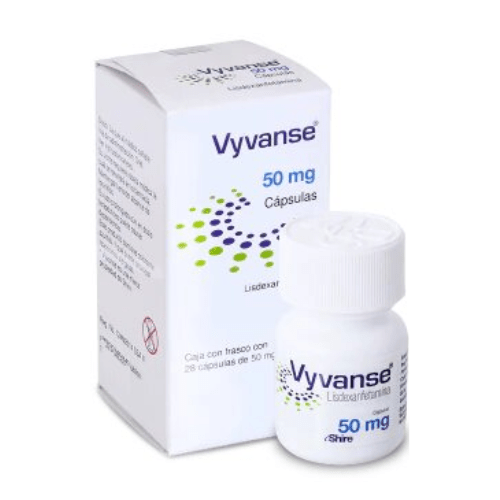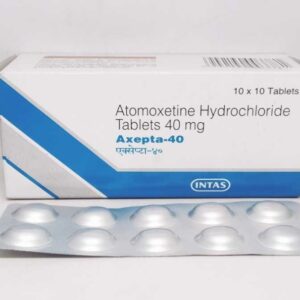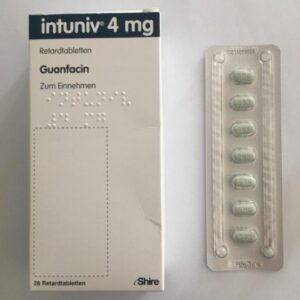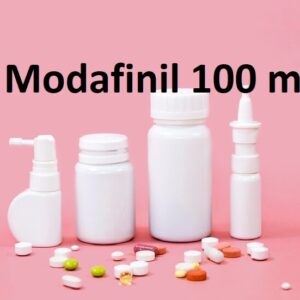Vyvanse, known generically as Lisdexamfetamine, is a central nervous system stimulant medication prescribed for the treatment of attention-deficit hyperactivity disorder (ADHD) and binge eating disorder (BED). Lisdexamfetamine 40 mg represents a common dosage strength used in the management of these conditions, providing a balance between therapeutic efficacy and tolerability. This comprehensive guide aims to delve into Lisdexamfetamine 40 mg, covering its mechanism of action, therapeutic uses, recommended dosage, potential side effects, precautions, and important considerations for safe and effective use.
Understanding Vyvanse (Lisdexamfetamine) 40 mg: Lisdexamfetamine is a prodrug of dextroamphetamine, which is a potent central nervous system stimulant. Once ingested, Lisdexamfetamine is metabolized in the body to dextroamphetamine, which acts primarily by increasing the release and blocking the reuptake of neurotransmitters such as dopamine and norepinephrine in the brain. These neurotransmitters play key roles in regulating attention, focus, and impulse control. By enhancing their activity, Lisdexamfetamine helps alleviate the symptoms of ADHD and BED, leading to improved cognitive function, behavioral control, and appetite regulation. Lisdexamfetamine 40 mg provides a moderate dosage strength suitable for achieving therapeutic efficacy in these conditions while minimizing the risk of adverse effects.
Uses and Indications: Lisdexamfetamine 40 mg is indicated for the treatment of attention-deficit hyperactivity disorder (ADHD) in children, adolescents, and adults. ADHD is a neurodevelopmental disorder characterized by persistent patterns of inattention, hyperactivity, and impulsivity that significantly impair daily functioning and quality of life if left untreated. Lisdexamfetamine is also approved for the treatment of binge eating disorder (BED) in adults, a condition characterized by recurrent episodes of uncontrollable binge eating followed by feelings of guilt, shame, and distress. By providing relief from these symptoms, Lisdexamfetamine enhances the quality of life for individuals affected by ADHD and BED.
Efficacy and Benefits: Clinical studies have demonstrated the efficacy of Lisdexamfetamine 40 mg in reducing symptoms of ADHD and binge eating disorder, leading to improved functional outcomes and quality of life in affected individuals. The moderate dosage strength offers a balance between therapeutic efficacy and tolerability, allowing for adequate symptom control while minimizing the risk of adverse effects commonly associated with higher doses or other central nervous system stimulants. Lisdexamfetamine typically begins to take effect within 1 to 2 hours after administration, with peak effects occurring within 2 to 4 hours. The duration of action varies depending on individual response and metabolism but generally lasts for several hours, necessitating once-daily dosing to maintain symptom control throughout the day.
Dosage and Administration: The recommended dosage of Lisdexamfetamine 40 mg is determined based on individual response, tolerability, and severity of symptoms. It is typically administered orally once daily in the morning, with or without food, to maintain therapeutic blood levels and provide sustained symptom control throughout the day. The dosage may be titrated gradually based on clinical response and tolerance, with regular monitoring by a healthcare professional to optimize therapeutic outcomes and minimize the risk of adverse effects. It is important to follow the prescribed dosage and administration instructions provided by the healthcare provider to achieve optimal treatment outcomes while reducing the risk of medication misuse or overuse.
Side Effects and Precautions: While Lisdexamfetamine is generally well-tolerated, it can cause certain side effects, especially at higher dosage strengths such as Lisdexamfetamine 40 mg. Common side effects include insomnia, decreased appetite, weight loss, irritability, and dry mouth. These effects are usually mild to moderate in intensity and transient, resolving spontaneously with continued use or dose adjustment. However, more serious adverse reactions such as cardiovascular events, psychiatric symptoms, and growth suppression are rare but require immediate medical attention. It is important to use Lisdexamfetamine with caution in individuals with certain pre-existing medical conditions such as cardiovascular disease, hypertension, glaucoma, and history of substance abuse. Additionally, Lisdexamfetamine may interact with certain medications, including monoamine oxidase inhibitors (MAOIs), selective serotonin reuptake inhibitors (SSRIs), and tricyclic antidepressants (TCAs), leading to potentially serious drug interactions and adverse effects.
Conclusion: Lisdexamfetamine 40 mg is a valuable medication for the treatment of attention-deficit hyperactivity disorder (ADHD) and binge eating disorder (BED), providing significant relief from symptoms of inattention, hyperactivity, impulsivity, and binge eating behavior. With its moderate dosage strength and central nervous system stimulant properties, Lisdexamfetamine offers effective symptom control while minimizing the risk of adverse effects commonly associated with higher doses or other stimulant medications. However, it is important to use Lisdexamfetamine responsibly, under the guidance of a healthcare professional, and to be aware of potential side effects, precautions, and drug interactions. By understanding the therapeutic uses, dosage recommendations, and safety considerations associated with Lisdexamfetamine 40 mg, individuals with ADHD and BED can make informed decisions regarding their treatment options and achieve better management of their symptoms.





Reviews
There are no reviews yet.